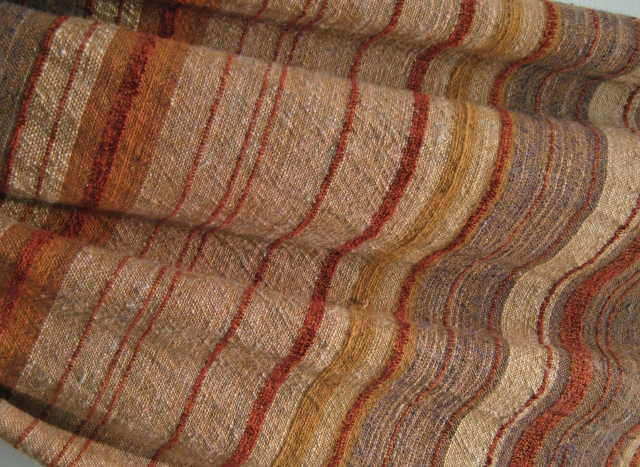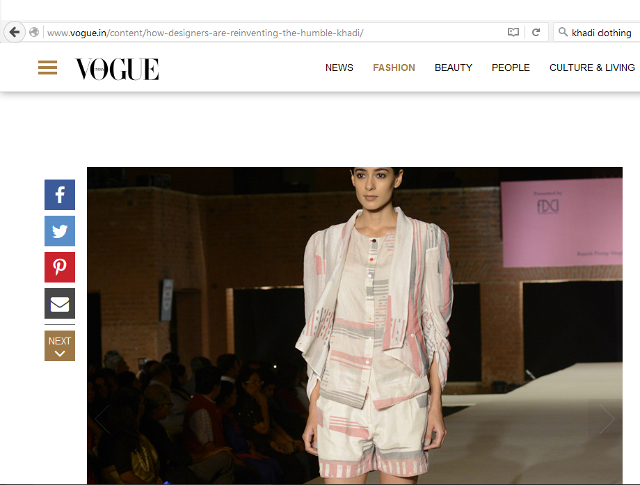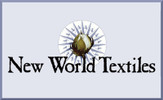|
Zanshi Khadi (leftovers, hand spun and hand woven) Level: Very simple, you only need 2 shafts --you can do it on a Saori loom. If you spin a thicker yarn, you could also do it on a rigid heddle loom with thicker warp yarns. Zanshiori has to do with weaving leftover yarns, and that is the easiest way for me to accomplish something random. The weft is all small bits of charkha-spun cotton singles that did not belong to any particular project; small in this case meaning less than a spindle full of any one color. This gave weft stripes of random color and width. Because I had such a mishmash of yarns for the weft, I put on a multicolored warp that would give some interest and go with all of the weft colors. I used 20/2 warp yarns, and my handspun runs between 12s and 15s. I wove about 5 yards, and still had plenty of the weft yarn left. This piece hung in the yardage exhibit at Convergence in Tampa and won an Honorable Mention. The hand is scrumptious; the energy in the singles gives the fabric a resilience that you can't get in a plied yarn. |
|
|
Zanshi Khadi (leftovers, hand spun and hand woven) Natural brown cotton warp, 10/2. Mostly charkha spun cotton singles, various colors. The dark orange is commercial chenille, all the rest is handspun. |
 |
|
Zanshi Khadi Look at this!! Be inspired!! NO, I did not weave it or fashion it into this beautiful outfit. You can see I Googled "Khadi clothing" to find it. The website is given above the picture, but I've embedded the link. Just click on the image to go to the website. There is a slide show, and this is slide #8, designer 11.11. From their Facebook page, "What 11.11 represents : |
 |
|
Shadow Huck It's just another way of doing color & weave. Shadow weave as a general rule alternates 2 colors in a weave structure to get a visual effect. When the weave structure is huck, the colors do not alternate across the warp, but alternate within the unit. Which means the ground threads are one color and the pattern threads another. Here is a simple 4-shaft example, with sections of the weft in the ground color only, then a border in the shadow style. The warp is in the horizontal direction in the picture. Commercial warp, cotton handspun on a charkha for weft. Click on the image to download the wif file.
|
 |
|
Or 3-thread Huck? As handweavers we are accustomed to a 5-thread huck, but it can be any odd number. The larger, of course, the longer the float, so unless you are using fine yarns you don't see a 7, 9, or 11 thread huck. For some reason unknown to me, a 3-thread huck is not common either. But here goes, with a video on how to design "Diversified Plain Weave". Nothing says you can't use a 5-thread huck (or 7, or more...) for "Diversified Plain Weave". A photo of a woven and dyed piece is here. |
|
|
Summer &Winter in Thick & Thin This 8 shaft draft of puzzle pieces can be found in Strickler, #545. You are accustomed to weaving summer & winter in two colors, but what if you changed thickness instead? I like to weave with one shuttle, so modified this draft to weave with 10/2 and 5/3 alternating in the warp and used 10/2 as the weft. The sett is 16 epi, though you could go to 18 if you wanted to. My modification also includes reducing it from 14 treadles to 9. I wove a sample in organic cotton thinking of a baby blanket. My modified wif is here. |
` |

